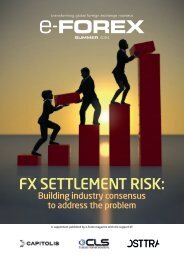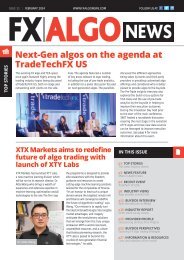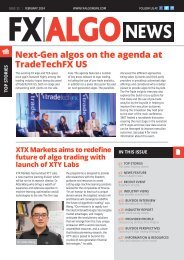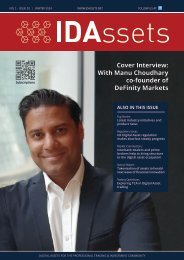You also want an ePaper? Increase the reach of your titles
YUMPU automatically turns print PDFs into web optimized ePapers that Google loves.
TRADERS WORKSHOP<br />
Achieving and maintaining an ultra-low latency FX trading infrastructure<br />
“Achieving ultra-low latency requires a holistic approach that<br />
meticulously optimises each step from data transmission to<br />
execution”<br />
Alexander Culiniac<br />
Ultra-low latency trading can be<br />
defined as a system capable of<br />
processing data in nanoseconds,<br />
compared to standard low latency<br />
which is measured in milliseconds<br />
or microseconds. Bridging this gap<br />
is expensive, though, and requires<br />
specialised hardware and software.<br />
“It is not just about going faster; it’s<br />
about designing a sleek, custom built<br />
engine capable of conquering those<br />
tiny fractions of time that make all the<br />
difference in high stakes trading,” explains<br />
Ariel Silahian, Director of Electronic<br />
Trading at SiS Software Factory.<br />
You can pay to be as close to the<br />
exchange as possible, but with<br />
equitable access you can only get<br />
as close as other participants states<br />
Gordon McArthur, CEO of Beeks<br />
Group. “If you have fixed latency<br />
budgets then your competitors<br />
generally do as well, so ultra-low<br />
latency is about ensuring all other<br />
elements of your trading system are as<br />
fast as possible,” he says.<br />
The number of participants in<br />
the market at different stages of<br />
implementing ultra-low latency<br />
limits the benefits since interactions<br />
between two parties will only be<br />
as fast as the slowest participant<br />
observes Alexander Culiniac, CTO/<br />
Managing Director of the commercial<br />
banking & payment product business<br />
group at SmartTrade Technologies.<br />
ATTENTION TO DETAIL IS VITAL<br />
“An FX trading platform must contend<br />
with various latency types, such as<br />
network, propagation, processing, and<br />
software-related delays,” says Culiniac.<br />
“Achieving ultra-low latency requires<br />
a holistic approach that meticulously<br />
optimises each step from data<br />
transmission to execution.”<br />
The primary users of these systems<br />
include high-frequency trading<br />
firms, hedge funds, and market<br />
makers, although as the value of<br />
improved performance rises relative to<br />
infrastructure costs, firms across the<br />
sell-side and buy-side are looking to<br />
achieve ultra-low latency.<br />
Silahian notes that the decentralised,<br />
fragmented nature of the FX market<br />
presents some specific challenges.<br />
“Unlike equities, FX is more about<br />
exploiting delayed prices across<br />
different platforms,” he says.<br />
“Execution speed is generally a little<br />
slower - even the fastest margin FX<br />
broker isn't as quick on the draw as<br />
Nasdaq. In addition, looser regulation<br />
in FX leads to protective measures<br />
by market players against high speed<br />
trading strategies, such as speed<br />
bumps or last look.”<br />
“The primary protocol for FX market<br />
data and trading is slow, lacks traceable<br />
timing, and is peer-to-peer rather than<br />
multicast observes McArthur. “Some<br />
FX markets have started to offer lower<br />
latency multicast market and binary<br />
trading protocols, but these are still<br />
in the minority,” he says. “With no<br />
single source, it takes a lot more time<br />
and effort to apply the methodical<br />
approach to ensuring latency-tuned<br />
access between participants.”<br />
Specific factors that impact latency<br />
include:<br />
• Slow infrastructure (servers/network<br />
cards/switches)<br />
• Additional infrastructure adding<br />
hops (firewalls, layers of switches)<br />
The decentralised, fragmented nature of the FX market presents some specific challenges<br />
• Physical distance from trading<br />
counterparties<br />
70 NOVEMBER 20<strong>23</strong> e-FOREX
















